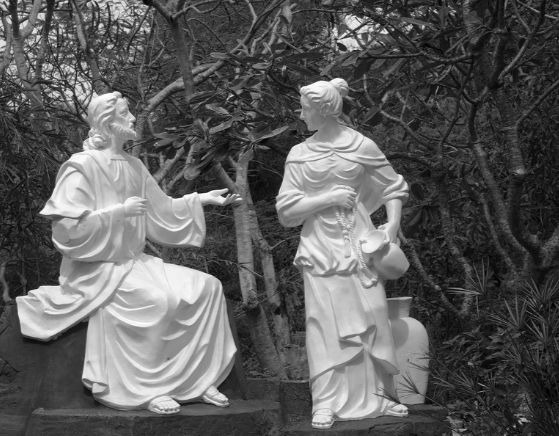What Is the Gospel of Mary Magdalene Really About?

{source}
These are times of a symbolic resurrection of Mary Magdalene, as, despite all the vilification she has experienced at the hands of institutionalized religions, fascination with her as the archetype of the fully developed Divine Feminine increases daily.
Recently, even National Geographic — for those who like to refer to mainstream media — made a documentary about a skull venerated by the split French Christian group persecuted as heretics (the Cathars), asserting it is the skull of Mary Magdalene. Scientists made 3D images of how her face might have looked; this was a very moving moment for many people around the world — to see an equivalent of the shroud of Turin, but for Jesus’ companion and female disciple, Mary Magdalene.
There are many fascinating alternative theories regarding the different possible lives of Mary Magdalene. However, they have all been written by people who came along centuries after her, who have been fascinated by her unique story. But I would like to return to the very source of this all — the actual Gospel of Mary Magdalene — and ask a very simple question: What is really in the Gospel of Mary Magdalene?
I think you will find its content enlightening and fascinating. This could also give a glimpse of understanding as to why this Gospel was not included in the canonical Bible.
Before we move to the content of the Gospel of Mary Magdalene, I would like to remind you of how we know about this at all, and to clear up some misunderstandings.
The modern discovery of the Gospel of Mary Magdalene occurred in 1896, when a British adventurer found the document in Egypt and left it in the care of the Berlin Museum. The scroll of the Gospel was not translated until 1955, and that translation was very literal and made little sense.
This often happens when a symbolic or esoteric text is translated by a linguist with no understanding of the subject of the translation. It took many more years before readable translations were finally available, with the best of them made by French scholar Jean-Yves Leloup, which in turn was translated from French into English.
Parts of the Gospel of Mary Magdalene are missing and thus the translation is incomplete, but it is revealing and wonderful nevertheless. The text of the Gospel starts with Page Seven, as the first six pages are missing.
The translation begins with Peter asking The Teacher questions; The Teacher finishes each answer in the same way as he does in the Gospel of Thomas, saying, “Those who have ears, let them hear,” which was, as far as we know, the manner in which Yeshua/Jesus spoke.
One of the most interesting questions in the entire Gospel of Mary Magdalene appears on that same page, when Peter asks, “What is the sin of the world?” And The Teacher gives His answer, “There is no sin.”
Now, for anyone brought up in any Abrahamic tradition — and in my case, as a Catholic — this is the discovery of a lifetime, and Jesus’ answer goes directly against the teachings of institutionalized religions of the West. Ladies and gentlemen, I repeat: There is no sin!
That is not the end of it. The Teacher then explains that the suffering we experience is due to our own actions, as we surrender to our conditioned, habitual behavior, often based on our lower or corrupted nature. We do have a choice, however, of not acting on our lower instincts and acting instead according to our higher nature, which can reunite with the Source or the roots of our being.
This reminds me a great deal of the teaching of karma — not as a fatalistic preordination of your destiny, but as the wisdom of choice on our part. The message here is that we can choose. We don’t have to become victims of our lower tendencies. We can start acting from our higher selves instead.
In the same manner, on Page Eight of the Gospel text, Yeshua/Jesus explains the importance of balance in our lives, in living in harmony with our true nature, and allowing true peace to arise in us. How do we do this?
We do this by not listening to people or other forces in our lives that point to things outside of ourselves for fulfillment — because we can never find true fulfillment outside of ourselves. We can only find fulfillment within ourselves (“For it dwells… within you”).
I find this passage very relevant to these times, when we are daily and constantly brainwashed by mainstream media with news and, even worse, reality shows that are based solely on superficial externalities that take us away from the true meaning of our lives, and want us to focus on the banalities and remain in constant fear of some disaster.
Then The Teacher says that He did not come to impose any laws upon us so we would not become bound by them. If finding the inner connection with the Divine in our own selves is the spiritual goal of our lives, we are not going to find it through blind obedience.
Spiritual growth requires exploration and asking difficult questions because this is the only way to a connection with the Truth — through our own investigations and by not listening to what others are telling us, especially institution-based others who might have their own agendas for keeping us ignorant of the Truth.
The second part of the Gospel of Mary Magdalene describes the classic Gnostic conflict between Mary Magdalene and Peter, who for Gnostics represents the hierarchical structure of the Church ignorant of the true teachings of Yeshua/Jesus.
At first, on Page 10, Peter says to Mary Magdalene, “Sister, we know that The Teacher loved you differently from other women.” Then he asks Mary Magdalene to tell the other disciples what The Teacher shared with her but not with them. At this point, Mary Magdalene confers to the disciples Yeshua/Jesus’ teachings on the Ascension of the Soul, which He had given her in a vision.
The teaching of the Ascension of the Soul describes the stripping back of different elements of destructive habits, such as jealousy, ignorance, etc., until the soul, liberated from all of them, reaches the Eternity of Time.
At this stage, Peter becomes jealous that The Teacher has not shared this wisdom with him, and he utters the famous words which are still repeated by the patriarchs of modern institutionalized religions around the world: “How is it possible that The Teacher talked in this manner with this woman about secrets of which we ourselves are ignorant? Must we change our customs and listen to this woman? Did he really prefer her to us?”
His rant is interrupted by Levi, who tells Peter to not be so hot-tempered, because the Teacher held her worthy and knew her well because he loved her more than us.
The Gospel of Mary Magdalene is still revolutionary, and at the same time, it speaks the truth to us about our own spiritual empowerment, about seeking the Divine within, not outside. The Gospel warns us against surrender to the empty worship of external distractions and the powers that be.
I think it is an especially beautiful timeless reminder about our inner lives, especially in these modern times of rampant materialism and what Carl Jung called the living dead — the masses of people, us included, who, through institutionalized brainwashing, forget their true inner glory in the midst of material trappings and the banality of the mainstream media.
We are told that we are created in the image of God, yet are asked to give away our freedom and thinking on a daily basis.
The Gospel of Mary Magdalene is a beautiful call for us to wake up and discover our inner glory.
“Those who have ears, let them hear.”
***
Dr. Joanna Kujawa is the author of Jerusalem Diary (a spiritual travelogue) and many short stories, essays and academic pieces. She sees herself as a Spiritual Detective who asks difficult questions about spirituality, such as ‘Can spirituality and sexuality be experienced as one?’, ‘Who was the real Mary Magdalene?’, ‘How can we include eco-spirituality in our belief systems?’ and ‘How can we bring back the Divine Feminine to create a more balanced and interconnected world?’ Her goal is to create and participate in the shift in consciousness about spirituality, our connection to nature, and our place in the Universe. She has PhD from Monash University, and MA and BA from the University of Toronto. She is immoderately passionate about her Goddess News blog. You could connect with her via her website, Facebook, Twitter or YouTube.
***
{Join us on Facebook, Twitter, Instagram & Pinterest}

